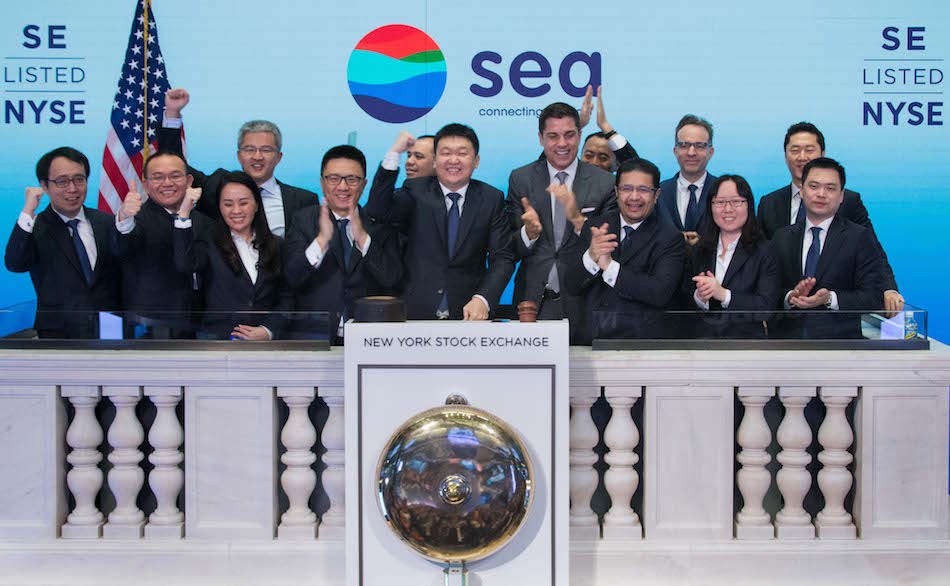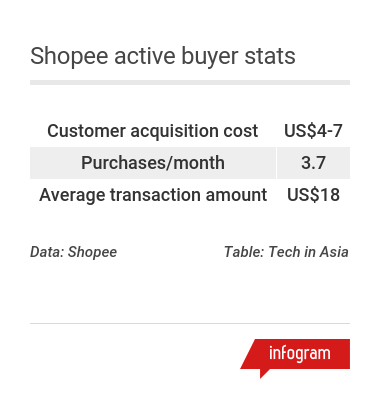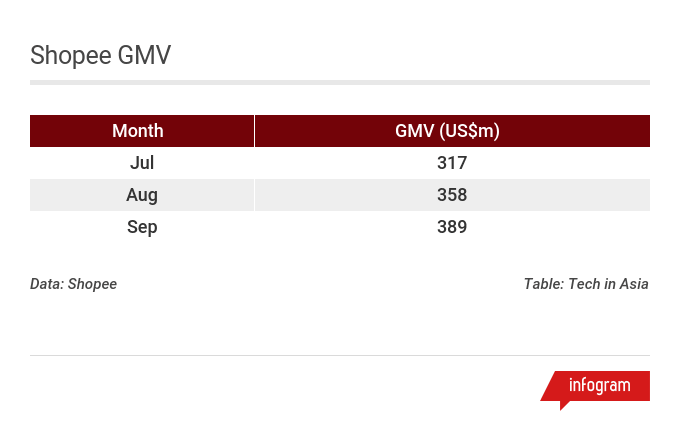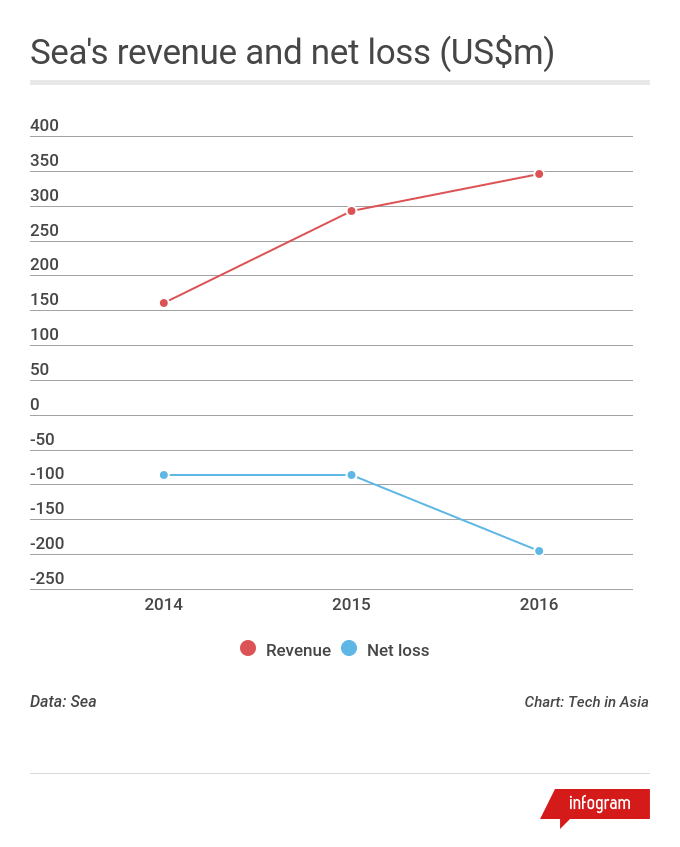
Sea chairman and CEO Forrest Li and president Nick Nash on the podium of the New York Stock Exchange on Friday. Photo credit: NYSE.
As you ride along the highway from Jakarta’s airport to the city, a giant billboard bearing the Shopee orange peeks from the horizon. “The number one online shopping destination,” it proclaims in Bahasa.
Shopee’s climb to the top of the Southeast Asian ecommerce heap has been rapid. The strategy that brought it to where it is today will guide it into the future.
And it’s not just about having a massive marketing budget. “The asset-light model is, we believe, ideally suited to the level of logistics infrastructure development of our region,” said Nick Nash, president of Singapore-headquartered Sea, who spoke at Tech in Asia Jakarta 2017. The conglomerate that runs Shopee, Sea concluded the most valuable public listing of a Southeast Asian internet company on the New York Stock Exchange.
 Logistics in Indonesia is one of the least economical in the world because of traffic jams and poor port efficiency. And given that the country is an archipelago, supply chains are long and fragmented. It could take as long as 18 years for the country to reach the level that Japan enjoys today.
Logistics in Indonesia is one of the least economical in the world because of traffic jams and poor port efficiency. And given that the country is an archipelago, supply chains are long and fragmented. It could take as long as 18 years for the country to reach the level that Japan enjoys today.
Shopee is trying to overcome that by allowing anyone to sell on its marketplace. The strategy has resulted in 1.6 million active sellers listing 74 million products as of the end of June. By crowdsourcing sellers from all over Southeast Asia and then giving them logistics, marketing, and payments support, Shopee says it can more efficiently meet consumer demand than a centralized and asset-heavy model – and without the high costs.
This empowers small business owners, who in turn provide jobs for the community. For example, an entrepreneur has hired half his village to make handbags and sell them on Shopee, not just nearby but throughout Indonesia.
“There is a key structural advantage from being asset-light: our sellers are highly distributed and decentralized across the region, rather than having to rely on one or a small number of mega-warehouses in larger cities,” says Nash.
“The very practical result is a more efficient path from seller to buyer as opposed to the potentially longer transit times under a hub-and-spoke model.”
Lazada, the Alibaba-owned marketplace dominating the business-to-consumer segment, runs 15 warehouses in Southeast Asia.
Why Shopee went consumer-to-consumer
Beyond overcoming logistical constraints, the approach goes hand-in-hand with Shopee’s focus on fashion ecommerce. Because sartorial tastes are fickle and unique to each individual, fashion marketplaces manage a high amount of stock keeping units (SKUs).
“Just for a moment, put yourself in the shoes of the fashion merchandising executive who leads all product selection for an asset-heavy ecommerce firm. No matter how big your team, no matter how smart they are, there is almost no way that a direct purchasing or direct procurement team can come up with 74 million wonderful products for customers to buy. The supply chain management alone on the inbound side (from the factory) is almost impossible to manage,” says Nash.
He contends that fashion in Southeast Asia is especially diverse. “I love to say that the accents in Indonesia change every 50 kilometers and the language spoken changes every 250 kilometers. Now imagine how that filters down to tastes, consumer preferences, and in this specific case, fashion preferences.”
So while an asset-heavy approach works well for the three Cs of computers, cell phones, and cameras, it will not do for fashion. That is because the electronics category often involves a limited number of SKUs. Further, asset-heavy players have the procurement scale to get big discounts from manufacturers.
“In phones, there are five original equipment manufacturers that matter – Oppo, LG, Samsung, Apple, and Xiaomi,” says Nash.
This consumer-to-consumer approach appears to be working. Sellers on Shopee moved US$389 million worth of goods (gross merchandise value or GMV) in September in what the company calls Greater Southeast Asia – consisting of the entire Southeast Asia and Taiwan. The fashion category makes up a third of that figure.

Nash presses his claim that Shopee is number one in Southeast Asia (excluding Taiwan) in the asset-light and women’s category, and overall, it is larger than all other ecommerce players by daily orders and GMV.
However, Lazada’s chief executive Max Bittner had previously questioned Shopee’s assertion.
“GMV is a metric which is easily inflatable by subsidy schemes and history shows that GMV falls away as unhealthy subsidies are removed. Also, it is no industry secret that marketplaces with no transaction costs and no/low revenues are highly subject to fraud, which is further driving unsustainable GMV,” he said in a statement to Tech in Asia.
However, Nash counters that Shopee’s sales and marketing spend – as a percentage of GMV – has gone down. It was 15.3 percent in the first half of 2016. It is now less than seven percent in the same period this year. In that duration, its GMV grew five times.
Also, while Shopee has not fully rolled out its revenue model yet, Nash claims that the marketplace’s growth hasn’t been impacted by its monetization efforts. For example, when it started collecting commissions for every transaction in Taiwan in April, GMV and number of orders did not shrink. In fact, orders grew month-on-month at the same rate.
Shopee is now monetizing in three out of its seven countries, Nash adds. It began charging for its seller advertising service in Taiwan in February, and Indonesia in May. It is collecting cross-border transaction fees in Malaysia.
These efforts, however, are nascent. According to Sea’s prospectus, 90 percent of its revenue in 2016 came from Garena, its online entertainment business. That leaves only US$35 million for Shopee and AirPay, Sea’s payments arm. Meanwhile, Sea’s net loss has widened.

Yet there’s a chance Shopee can build a moat around the female, asset-light category from which it can then become profitable. “You wouldn’t go to Harvey Norman to buy a dress,” Nash says, adding that it is hard to jump from one model to another.
“It’s difficult to go from asset-heavy to asset-light. It’s about conflicts of interest. If you’re asset-heavy, your job is to buy wholesale, put it in your warehouse, and then sell one package at a time in great bulk.” That would put the marketplace at odds with its sellers.
But regardless of its ongoing race with its rivals, Shopee is betting on continued growth in Southeast Asia’s ecommerce industry to propel all boats. “The real competition is that 97 percent of retailers are still offline,” says Nash.
This post How Shopee plans to reign supreme in Southeast Asia’s fashion ecommerce scene appeared first on Tech in Asia.
from Tech in Asia https://www.techinasia.com/shopees-plan-win-fashion-ecommerce-southeast-asia
via IFTTT
No comments:
Post a Comment